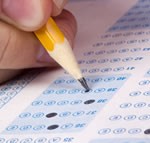
The millions of students who take the SAT or ACT each year will have to submit photos of themselves when they sign up for the college entrance exams, under a host of new security measures announced March 27 in the aftermath of a major cheating scandal on Long Island.
The two companies that administer the tests, the College Board and ACT Inc., agreed to the precautions under public pressure brought to bear by Nassau County District Attorney Kathleen Rice, who is overseeing the investigation.
The measures take effect in the fall.
“I believe these reforms, and many others which are happening behind the scenes, will prevent the kind of cheating that our investigation uncovered and give high schools and colleges the tools they need to identify those who try to cheat,” Rice said.
Rice has charged 20 current or former students from a cluster of well-to-do, high-achieving suburbs on Long Island with participating in a scheme in which teenagers hired other people for as much as $3,500 each to take the exam for them. The five alleged ringers arrested in the case were accused of flashing phony IDs when they showed up for the tests. All 20 have pleaded not guilty.
In one instance, a young man allegedly produced an ID and took the test for a teenage girl who had a name that could have been either male or female.
Students have long been required to show identification when they arrive for one of the tests. Under the new rules, they will have to submit head shots of themselves in advance with their test application. A copy of the photo will be printed on the admission ticket mailed to each student, and it also will appear on the test site roster.
School administrators are “going to be able to compare the photo and the person who showed up and say that’s either John Doe or that’s not John Doe. They didn’t have the ability to do that before,” the district attorney said.
The photo also will be attached to the student’s scores, which, for the first time, will be sent to his or her high school, so that administrators and guidance counselors can see the pictures. Previously, test results were sent only to the student.
“Millions of college-bound students who take the SAT and ACT each year can have a new confidence that their hard work and preparation will be rewarded and not diminished by cheaters,” Rice said.
Officials from the College Board and ACT Inc. said that any additional costs would be absorbed and not passed on to students. The College Board charges $49 for the SAT; ACT Inc. charges $34 for the basic test, $49.50 if it includes a writing exam.
“We believe these measures support both test integrity and access and equity for all students,” said Kathryn Juric, vice president of the SAT program for the College Board.
During the 2010-11 school year, nearly 3 million students worldwide took the SAT; 1.6 million students took the ACT in 2011.
In another key change, students will be required to identify on their application the high school they attend. In the Long Island scandal, the impostors often went to high schools in neighboring communities so they would not be recognized.
Bob Schaeffer, public education director of FairTest: National Center for Fair & Open Testing, a longtime critic of the SAT, said the new procedures still would not prevent cheating if a student submitted an impostor’s photograph.
“The image on the registration form will match up with that of the person taking the exam so long as an equally phony ID is used at the test site,” he said.
But Rice argued that the follow-up report to the student’s high school, with the photograph, should deter most cheating.
“Knowing that’s going to be going back to their high schools, specifically their guidance counselor, that’s the backup check that’s going to prevent it from happening,” Rice said. She also said the photos would be kept in a database should any questions of cheating arise later.
In addition, administrators will check student IDs more frequently at test centers. IDs will be examined when students enter a test site, whenever they re-enter the test room after breaks, and again when the answer sheets are collected.
Students will have to upload the photo of themselves or else mail it in.
Vivian Tam, a 17-year-old senior at the LaGuardia School for the Performing Arts High School in New York, welcomed the changes.
“Some people are getting better grades because they have more money to pay somebody to take the test for them,” she said.
- Extron AV Switching, Streaming, and Control Systems Aid Higher Learning at Idaho’s First Medical School - June 1, 2021
- Extron XTP, Streaming, and Control Systems Empower Point Park University’s Varsity Esports Program - June 1, 2021
- Extron NAV Series Delivers AVoIP Throughout Allied Health Veterans Hall at UNC Wilmington - June 1, 2021
